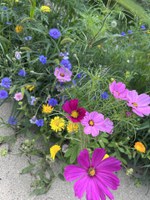Dakota Gardener: Growing wild
(Click an image below to view a high-resolution image that can be downloaded)
By Emily How, Horticulture agent
NDSU Extension – Ward County
One of my favorite spots at home is in my front yard. Between my driveway and the front walk there is a two-foot-wide patch of soil where I grow wildflowers. This is a test of my own plant identification skills, but also of my patience.
Every year I anxiously await the sprouting of flowers and hope that my neighbors don’t call the city for what looks like a weed patch. But come July, those unruly sprouts have burst into bloom and are filled with all sorts of beautiful colors, from purple and pink bachelor buttons to yellow sunflowers and white baby’s breath.
These wildflowers do more than bring interest and color to the front of my house, they provide a buffet of pollen and habitat space for many different pollinators. Almost 40% of the native bumblebees in the United States are native to North Dakota. These fuzzy little pollinators cannot fly as far as other bees can and providing them with food and habitat is essential to bumble bee survival in an urban area.
Speaking of native bees, did you know that there are over 4,000 native bee species in the U.S? Most of which are solitary bees, meaning they do not live together in hives or social colonies like honeybees or bumble bees. In fact, many solitary bees, such as the sweat bee, live in the ground. These bees need flat, untilled soil to build their nests. By having a patch of wildflowers, I have an untilled, undisturbed place for the bees to live during the winter months. It also provides an essential food source for the native solitary and social bees.
Creating your own wildflower patch is easy. The most important part is finding a spot in your yard that you can leave unmown and untilled. Remove any existing plant matter and scratch the soil up with a rake. Plant wildflower seeds, then water. Try to use wildflower seeds that are native to North Dakota, such as yarrow, sunflowers, coneflowers, blanket flowers and wild bergamot. You can also include other popular wildflowers that will reseed themselves every year, like bachelor’s buttons, poppies and cosmos. Make sure to have a mix of annuals and perennials. Finally, sit back and watch as your wildflowers take off!
You can create the same environment on your patio using pots and planters of assorted sizes. Using larger pots (at least 12 inches in diameter and depth) and mulching can provide more insulation for the plants to survive the winter. Plants such as coneflower, sage, columbine and chives grow well in pots and are great pollen sources.
I forgot to mention the best part about a wildflower patch, I don’t have to weed out all the dandelions! Honestly, I rarely weed this patch at all. The foxtail grass fills in spaces where wildflowers are not growing and helps increase the drainage and limit erosion. The black medic fixes nitrogen in the soil, which means I don’t have to fertilize and provides another food source for the bees. Every plant that is growing in this space provides some sort of benefit.
This year, try growing something wild.
NDSU Agriculture Communication – Aug. 8, 2025
Source: Emily How, 701-857-6444, emily.how@ndsu.edu
Editor: Kelli Anderson, 701-231-6136, kelli.c.anderson@ndsu.edu




